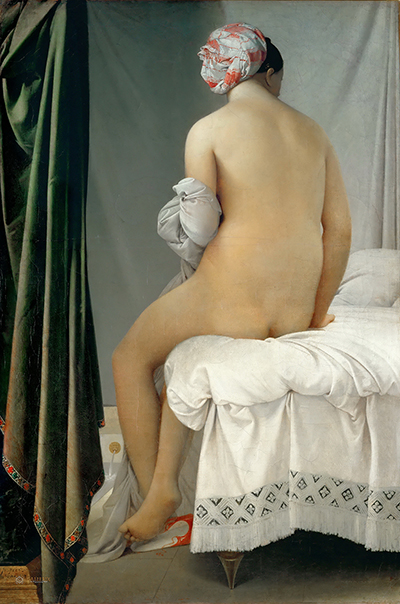The Valpinçon Bather captures Ingres' style of allowing women to be portrayed with a little extra weight, prefering a more realistic depiction of the beautiful female body. This honesty is respected in today's world, but was not to everyone's satisfaction in the early 19th century.
On the face of it, there is simply a female with her back turned to us in a domestic scene. Artistically, however, there is a lot of detail to appreciate here - Ingres famously included stunning drapery within many of his portraits, adding a touch of class to elements of the background. The main setting would tend to be fairly plain, with features then dotted around the model to add interest. In this case, there is a plain cloth placed across the back, with a dark green curtain framing the composition to the right. She sits on a comfortable bed, with Ingres then including detail of the under-carriage of this furniture. It is intended to be a personal setting, though with the mystery of the model who we cannot see face-to-face.
Addiitonally, the model wears a simple wrap around her hair and also pulls some of her duvet over her midrift. Whilst this portrait was completed in 1808, The Turkish Bath from 1862 makes use of the very same figure and pose. It is undeniably similiar, almost identical, though placed into a very different composition. Re-use of figures like this is not uncommon within artist's careers, though normally it occurs when an artist produced study pieces for a finished painting in the near future, rather than half a century later. The Valpinçon Bather can be found as part of the collection of the Louvre, who own a number of Ingres' pieces. Related artists who can also be found here include Gericault, Delacroix, David and Courbet.
A citation from the time explains the Louvre's love for this piece, exclaiming it to be , "...a masterpiece of harmonious lines and delicate light". The title for this painting was originally, Seated Woman, but the newer name derives from one of the earliest owners of the piece. This has occurred in other artist's careers, where an owner becomes part of the title. There is a possibility that some sculptures by Antonio Canova may have influenced this piece, such as Venus Italica (1812), or a similar earlier piece that arrived before this painting was commenced.




